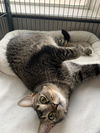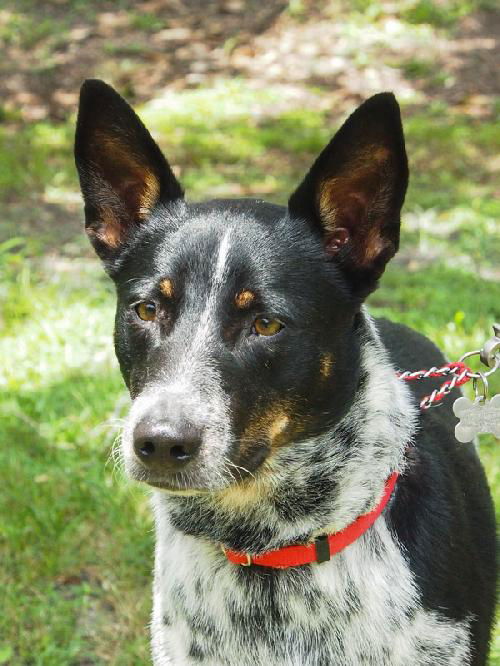
| My Rescue |
| Login to Remember your Favorite Animals and Breeds! |
Zip and his brother were captured by Animal Control after a caller said she had two wild coyotes in her yard. Animal Control arrived and found two very scared 7-8 month old heeler puppies huddled against the fence. They didn't snap, growl or even move when approached.
Zip was adopted by a family a few months later after he had been somewhat socialized and learned to walk on a leash. He was returned after they had him for 15 months because they felt he was too protective of their home. He bit a painter on his knee (luckily he was wearing knee pads) when they put Zip in the yard and forgot the painter was there. They also said he nipped a girl’s knee when she came on the porch where they kept Zip a lot because their yard wasn’t fenced.
Zip did learn to stay on their property without a leash. They seemed to really care about him but were nervous that he might bite (cattle dog nip) again because they have 3 children and their friends visit a lot. Zip is back with his original foster and is doing well – no aggression issues. Two 11-year old boys and their dog visited their home with no issues. Zip welcomed the dog and let the boys pet him. They are continuing to socialize and train him.
Zip needs an owner who will be patient with him as he learns to trust them and find the confidence to be wonderful companion!
FOSTER UPDATE:
- Leash Manners: Walks well on leash and enjoys riding in a car.
- Crate/House Training: House trained (no accidents). He sleeps in the crate at night. He is good in the house and has no chewing issues so he’s not crated thru the day. He responds well to a calm, firm voice.
- Socialization: Zip plays well with my dogs and enjoys meeting new dogs at the dog park. Sometimes he gets excited when he meets a new dog and barks but they usually start playing and enjoy chasing each other. If I think he scares the dog, I tell him “leave it” and he usually stops and finds someone else to play with. If he doesn’t I put him on the leash for a couple of minutes to distract him. He doesn’t seem to notice people at the park – just enjoys the freedom of running and meeting new dogs. He stays with my dogs as we go thru the park.
- Energy Level and Exercise: Moderate energy – Zip enjoys the freedom of the yard and playing with dogs. He gets excited when he sees the leash and loves walks, car rides and the dog park. He chases toys or balls but usually doesn’t bring them back – we’re working on this. His breed usually enjoys playing fetch with a ball or Frisbee.
- Daily Structure and Schedule: We walk 1 mile at 6:15 am, he plays outside with our dogs and then has 1 cup of food. He tosses toys around inside or finds a quiet spot to rest and naps for 2-3 hours. We have a dog door so he goes out in the yard a couple of times thru the day. He has 1 cup of food around 6 pm and then plays in the yard, goes for a walk, bike ride or to the dog park. He gets a treat and goes in the crate at 9 – 9:30 pm. He walks 2 miles on the weekend.
- Confidence Level: Zip is fairly comfortable with everyone in our home. He walks right up when he wants petted. He enjoys having his chest rubbed. He’s not a lap dog but does enjoy attention and being in the room with us. He enjoys hanging out in our college age son’s room. He is timid with people he doesn’t know when they walk towards him so I put him on the leash when we have visitors and let him slowly meet them or put him in another room. He is confident with dogs.
- Obedience Training: He knows “sit” and sits for a treat or his meal. He knows “come” and “wait” at the door. He makes great eye contact and seems to want to please, so he should be easy to train. He is treat motivated.
- Behaviors: Zip enjoys meeting new dogs but is timid with new people. I think he may become more comfortable in time. He’ll make a great companion dog. His collar came off while we were walking and he sat and waited to have his collar put back on. He seems to want to be near his person.
- Personality Quirks: Zip is timid with new people but will usually take a treat they offer. He’s fairly comfortable with people he sees often and seems to really like boys (10 or older).
- Ideal Home: Zip would love a home with a single person, a couple or a family with older children. He would probably do best in a home with another playful dog so he could quickly learn to trust the new owner because their dog does. He is active so he would enjoy a fenced yard and will be well behaved inside for someone who can take him for a long walk or jog daily.
According to www.dogbreedinfo.com, the Australian Cattle Dog was developed by pioneer settlers in the 19th century to herd cattle on large ranches. Dogs the settlers brought with them from Europe, called Smithfield and the Old Smooth Collie (not the smooth collie known today), were not able to handle the long distances and inhospitable climate of the new continent. So ranchers began experimenting with new crosses. The Australian Cattle Dog primarily derived from a mix of smooth, blue speckledCollie imports from Scotland and wild Australian Dingoes. Australian Kelpie, Dalmatian, and Bull Terrier were also added. The result was an excellent herding dog, with few equals, who worked the stock quietly yet forcefully, willing and able to drive cattle across vast distances under harsh, hot dusty conditions. With superior stamina, it was well suited to Queensland. Both its guarding and herding instincts are very strong and may extend to people and other animals. Robert Kaleski drew up a standard for the breed in 1893, which was finally approved in Australia in 1903. The Australian Cattle Dog was fully recognized by the AKC in 1980. The Australian Cattle Dog has also been known as the Australian Heeler, Hall's Heeler, Queensland Heeler or Blue Heeler. "Heeler" refers to its herding skill of snapping and biting cattle's heels. Its talents are retrieving, herding, guarding, agility, competitive obedience, and performing tricks.
A working, herding breed, the Australian Cattle Dog is not suited to life alone in the backyard. One of the most intelligent breeds, it can become easily bored, leading to serious behavior problems. These dogs need to be part of the action! They are loyal, protective and alert. An excellent guard dog. Brave and trustworthy. Very good in the obedience ring and in herding and agility. Can be obedience trained to a very high level. Firm training from the start and a lot of daily leadership, along with daily mental and physical exercise will produce a fine and happy pet. It is absolutely loyal and obedient to its master, but it is something of a one-person dog. They are sometimes suspicious of people and dogs they don't know. It can be very dog aggressive, for its dominance level is high. Teach your Australian Cattle Dog that you are alpha and you will not tolerate him fighting with other dogs. Best with children in the family it has known since puppyhood. Some tend to nip at people's heels in an attempt to herd them. If you are buying a pet, avoid strictly working lines, as these dogs may be too active and intense for home life. Australian Cattle Dogs are very easy to train. Puppies are born white (inherited from the early Dalmatian crosses), but the adult color can be seen in the paw pads. Problems can and WILL arise with meek owners, and or owners who do not provide the proper amount and type of exercise. This breed does best with a job to do. If you do not have time to extensively work with and exercise your dog, or do not fully understand canine instincts and their need to have leadership, this is not the breed for you.
Other Pictures of Zip the Shy Heeler Pup (click to see larger version):
 69k |
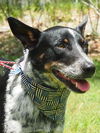 76.3k |
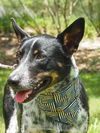 73k |
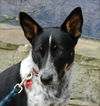 45.4k |
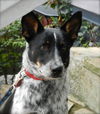 48.1k |
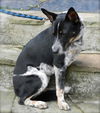 59k |
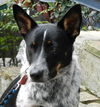 56k |
 45.4k |
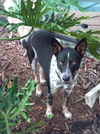 83.3k |
Copyright © Pet Rescue by Judy
